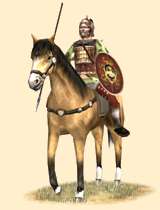Taxilan Agema (Indo-Iranian Heavy cavalry)
 |
Weapons | Defence | Mental | ||||||
|---|---|---|---|---|---|---|---|---|---|
| Primary | Secondary | Armour: | 12 | Morale: | 16 | ||||
| Type: | spear | sword | Shield: | 2 | Discipline: | disciplined | |||
| Attack: | 7 | 11 | Skill: | 13 | Training: | trained | |||
| Charge: | 15 | 15 | Recruitment | Other | |||||
| Lethality: | 1 | 0.11 | Soldiers: | 25 | Hit Points: | 1 | |||
| Range: | 50.4 | 0 | Cost: | 4311 | Mass: | 1 | |||
| Ammo: | 6 | 0 | Upkeep: | 1078 | |||||
| Turns: | 1 | ||||||||

Taxila agema is a heavy Indo-Iranian cavalry unit, with incredible defense due to its facemask and double cuirass. Only their unarmored horse keeps them from being true cataphracts.
Superior
Hardy
Heavy cavalry, exclusive to the Gandhara region, those mostly Indo-Iranian horsemen combine elements of both Hellenic weapon and armor mastery, and Indian excellent iron forging traditions. Wearing a Hellenic facemask made to resemble the syncretic deity of Zeus-Ahura Mazda with his distinct outflowing sunrays, armed with a small "cavalry" aspis shield, a spear and a kopis for close work and a leather cuirass, those alone would classify him a heavy cavalry. Yet, worn above the leather cuirass is the true Mauryan ion forging skills evident. Right on the edge of the facemask begin a circular leather shoulder and neck protector, with iron and bronze scales intertwined. His cloak, heavy at the shoulders for enhanced slash protection is basically two parts, that are tied together prior to battle. On top of his leather cuirass, a wooden frame is held together by leather straps. Therein either metal shards or rectangular lamellae are held together by the wooden frame, making a very Indian style "framed breastplate", on top of his hardened leather cuirass. An Iranian style pantaloon and perikneimeides' also known as greaves complete the picture.
Historicaly, closely after Alexandros died, his Indian pocessions became the property of one of the greatest Indian dynasties to come out of the Magadha area, the Mauryans, named after its founder Chandragupta Maurya. Be it his immitating of the tolerant Seleukid ways, be it that he felt gratitude toward the "Yavanas/Yonakas" mercenaries who helped him assume the throne, Chandragupta Maurya, allowed free reign on all. This is further demonstrated by his grandson Asoka Maurya, in his Bilingual (Greek and Aramaic) inscriptions at Kandahar/Gandahara (Shar-i-kuna). (3rd century BCE). They were preserved at the Kabul Museum.
Today they have disappeared. There he had written among other verses which proclaimed abstaining from killing..."and obedient to their father and mother and to the elders, in opposition to the past also in the future, by so acting on every occasion, they will live better and more happily". It has been suggested that Ashoka has had a quarter Greek blood, as his grandfather Chandragupta did marry Seleukos' daughter, but that is beside the point. It may be that his supposed quarter Greek ancestry did make him more hospitable towards Yavanas and other Northwestern "barbarians", but it is more prudent to assume that Ashoka had studied government, and had learned about Seleukos forging a kingdom out of nothing through "tolerance" and "synthesis" of foreign elements. This process would come to be known thousands of years later in a land far far away as "E pluribus unum".
It is rare that a fusion of cultures, ideas, religions and yes, warrior cultures happens. It is however very fortunate that in the cases that it does, units that combine all the great aspects of their perspective "schools of thought" so far as military technology of the time. The Greek facemask, maybe the best form of facial protection at the time would start a legacy that would last for at least 1500 years across all Asia. The small round shield, by no means a Greek invention, is still in use in India, in Kalaripayattu martial arts discipline. Kopis sword, is now known as Khukri and the resemblance to the Kopis is uncanny. The cuirass has certainly evolved away from what the Taxilan Agema wear. A heavy Nissean or Kambojan horse is what the Taxilan agema is mounted on, and even if it isn't armored, nobody can say the same for his rider. Taxilan agema will fight for whomever owns the regions that they are recruited in, and do so until they die, or their horses collapse from under them.